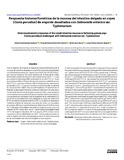Mostrar el registro sencillo del ítem
Respuesta histomorfométrica de la mucosa del intestino delgado en cuyes (Cavia porcellus) de engorde desafiados con Salmonella enterica var. Typhimurium
| dc.rights.license | http://creativecommons.org/licenses/by-nc-sa/3.0/ve/ | es_VE |
| dc.contributor.author | Bezada-Quintana, Sandra Gracia | |
| dc.contributor.author | Carcelén-Cáceres, Fernando Demetrio | |
| dc.contributor.author | López-Guerra, Sofía | |
| dc.contributor.author | Guevara-Vásquez, Jorge Ernesto | |
| dc.date.accessioned | 2023-11-03T15:50:42Z | |
| dc.date.available | 2023-11-03T15:50:42Z | |
| dc.date.issued | 2023 | |
| dc.identifier.issn | 0798-2259 | |
| dc.identifier.uri | http://www.saber.ula.ve/handle/123456789/49873 | |
| dc.description.abstract | Con el objetivo de evaluar la respuesta histomorfométrica de la mucosa del intestino delgado en cuyes (Cavia porcellus) desafiados con Salmonella enterica var. Typhimurium (SeVT) (2×10 6 UFC·0,5mL -1 por cuy) se tomaron 40 cuyes machos de 15 días (d) de edad, distribuidos aleatoriamente en cuatro tratamientos SeVT; 1.- cuyes que recibieron dieta base (DB) y se desafiaron con SeVT (T 1 ); 2.- cuyes que recibieron DB con 50 ppm de zinc bacitracina y se desafiaron con SeVT (T 2 ); 3.- cuyes que recibieron DB con 50 ppm de zinc bacitracina, sin desafío (T 3 ) y 4.- cuyes que recibieron únicamente DB, sin desafío (T 4, Grupo Control). Cada T estuvo conformado por 10 repeticiones. Al finalizar la fase experimental en la 8va semana (sem) se colectaron muestras de las secciones duodeno, yeyuno e íleon y se procesaron con hematoxilina y eosina (H-E) para el análisis histomorfométrico. Los parámetros evaluados fueron longitud de la vellosidad (LV), ancho de la vellosidad (AV), profundidad de la cripta de Lieberkühn (PC) y la relación longitud/cripta (LV/PC). Los datos se analizaron mediante análisis de varianza y la prueba de Tukey. Los resultados (promedio ± DE) fueron significativamente diferentes a P<0,05 en todos los T indicando vellosidades reducidas en longitud, ancho y con una relación LV/PC, menor de 2:1 en el T 1 , observando vellosidades hasta 40 % más largas en duodeno, 39 % en yeyuno y 55 % en íleon en los cuyes que no fueron desafiados con SeVT, concluyendo que existe un efecto negativo de este enteropatógeno sobre la histomorfometría de las vellosidades del intestino delgado en esta especie. | es_VE |
| dc.language.iso | es | es_VE |
| dc.publisher | SaberULA | es_VE |
| dc.rights | info:eu-repo/semantics/openAccess | es_VE |
| dc.subject | Cuyes | es_VE |
| dc.subject | Salmonella enterica var | es_VE |
| dc.subject | Typhimurium | es_VE |
| dc.subject | Histomorfometría intestinal | es_VE |
| dc.subject | Intestino delgado | es_VE |
| dc.title | Respuesta histomorfométrica de la mucosa del intestino delgado en cuyes (Cavia porcellus) de engorde desafiados con Salmonella enterica var. Typhimurium | es_VE |
| dc.title.alternative | Histomorphometry response of the small intestine mucosa in fattening guinea pigs (Cavia porcellus) challenged with Salmonella enterica var. Typhimurium | es_VE |
| dc.type | info:eu-repo/semantics/article | es_VE |
| dc.description.abstract1 | In order to evaluate the histomorphometric response of the mucosa of the small intestine in guinea pigs challenged with Salmonella enterica var. Typhimurium (SeVT) (2×10 6 CFU·0.5mL·guinea pigs -1 ), Fifteen- day-old guinea pigs (n=40) divided at random into four treatment (T) groups: 1.- guinea pigs that received a standard feed (SF) and were challenged with SeVT (T 1 ); 2.- guinea pigs that received a SF with zinc bacitracin (50 ppm) and were challenged with SeVT (T 2 ); 3.- guinea pigs that received a SF and were given zinc bacitracin (50 ppm) without challenge (T 3 ), and 4.- guinea pigs that only received a SF, without challenge (T 4 , Control Group). Each T consisted of 10 repetitions. At the end of the experimental phase in the eighth week, samples of duodenum, jejunum and ileum from each T group were collected and stained with hematoxylin-eosin (H-E) for histomorphometry analysis. The parameters examined included villus length (VL), villus width (AVL), Lieberkühn’s crypt depth (PC) and length/crypt ratio (LV/PC). Procured data were statistically analyzed using ANOVA and Tukey’s test. The results (mean ± SD) were significantly different at P<0.05 in all T indicating villus reduced in length, width and with a LV/PC ratio less than 2:1, observed villus up to 40 % longer in duodenum, 39 % in jejunum and 55 % in ileum in the guinea pigs that were not challenged with SeVT. It is concluded that there is a negative effect on the villus histomorphometry to infection with SeVT guinea pigs. | es_VE |
| dc.description.colacion | 1-9 | es_VE |
| dc.description.email | sbezadaq@unmsm.edu.pe | es_VE |
| dc.identifier.depositolegal | pp199102ZU46 | |
| dc.identifier.edepositolegal | ppi201502ZU4665 | |
| dc.identifier.eissn | 2477-944X | |
| dc.publisher.pais | Venezuela | es_VE |
| dc.subject.institucion | Universidad del Zulia (LUZ) | es_VE |
| dc.subject.institucion | Universidad de Los Andes (ULA) | es_VE |
| dc.subject.keywords | Guinea pig | es_VE |
| dc.subject.keywords | Salmonella enterica var | es_VE |
| dc.subject.keywords | Typhimurium | es_VE |
| dc.subject.keywords | Villus histomorphometry | es_VE |
| dc.subject.keywords | Small intestine | es_VE |
| dc.subject.publicacionelectronica | Revista Científica | |
| dc.subject.seccion | Revista Científica: Artículos | es_VE |
| dc.subject.thematiccategory | Medio Ambiente | es_VE |
| dc.subject.tipo | Revistas | es_VE |
| dc.type.media | Texto | es_VE |
Ficheros en el ítem
Este ítem aparece en la(s) siguiente(s) colección(ones)
-
Revista Científica - 2023 - Vol.XXXIII - Nº 001
Enero - Junio 2023


